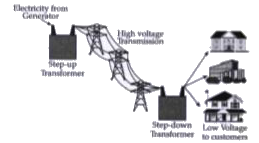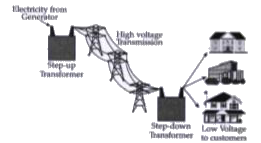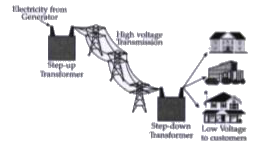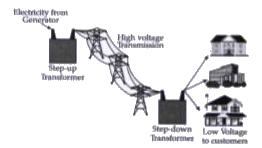Let a fixed amount of power be transmitted from an electricity power station to a nearby city. Suppose you have two options before starting and electricity supply. You can use either high voltage or low voltage to supply electricity.
which one would you choose keeping in mind that there are transmission losses due to resistance of electric cables used for supply ?
To determine whether to use high voltage or low voltage for transmitting a fixed amount of power from an electricity power station to a nearby city, we need to analyze the transmission losses due to the resistance of electric cables.
1. Understanding Power Transmission:
The power (P) transmitted can be expressed in terms of voltage (V) and current (I) using the formula:
P=V×I
2. Expressing Current in Terms of Power and Voltage:
Rearranging the formula gives us:
I=PV
This shows that the current is inversely proportional to the voltage when power is constant.
3. Calculating Heat Loss Due to Resistance:
The heat (H) generated in the transmission line due to resistance (R) can be expressed using the formula:
H=I2×R
Substituting the expression for current (I) from the previous step, we get:
H=(PV)2×R
4. Minimizing Heat Loss:
To minimize heat loss, we need to analyze the expression for heat:
H=P2×RV2
From this equation, we see that heat loss is inversely proportional to the square of the voltage (V). This means that as the voltage increases, the heat generated decreases.
5. Conclusion:
Therefore, to minimize transmission losses due to resistance, it is better to use high voltage for transmitting electricity. This reduces the current flowing through the cables, thereby decreasing the heat generated due to resistance.
The power (P) transmitted can be expressed in terms of voltage (V) and current (I) using the formula:
P=V×I
Rearranging the formula gives us:
I=PV
This shows that the current is inversely proportional to the voltage when power is constant.
The heat (H) generated in the transmission line due to resistance (R) can be expressed using the formula:
H=I2×R
Substituting the expression for current (I) from the previous step, we get:
H=(PV)2×R
To minimize heat loss, we need to analyze the expression for heat:
H=P2×RV2
From this equation, we see that heat loss is inversely proportional to the square of the voltage (V). This means that as the voltage increases, the heat generated decreases.
Therefore, to minimize transmission losses due to resistance, it is better to use high voltage for transmitting electricity. This reduces the current flowing through the cables, thereby decreasing the heat generated due to resistance.
Topper's Solved these Questions
- BOOK - MODERN PUBLICATIONCHAPTER - CURRENT ELECTRICITYEXERCISE - NCERT SOLVED (NCERT Textbook Exercises)13videos
CURRENT ELECTRICITY
- BOOK - MODERN PUBLICATIONCHAPTER - CURRENT ELECTRICITYEXERCISE - NCERT SOLVED (NCERT Additional Exercises)11videos
CURRENT ELECTRICITY
- BOOK - MODERN PUBLICATIONCHAPTER - CURRENT ELECTRICITYEXERCISE - CONCEPTUAL QUESTIONS35videos
CURRENT ELECTRICITY
- BOOK - MODERN PUBLICATIONCHAPTER - ATOMS EXERCISE - Chapter Practice Test16videos
ATOMS
- BOOK - MODERN PUBLICATIONCHAPTER - DUAL NATURE OF RADIATION AND MATTER EXERCISE - CHAPTER PRACTICE TEST15videos
DUAL NATURE OF RADIATION AND MATTER
Similar Questions
Dinesh is a student of 10th standard. He went to a remote area of Rajasthan for trekking with his friends. Dinesh found that it was a sparsely inhabited area. He was surprised to know that there was still no electricity in this area. The children also had to study with kerosene lamps at night. The village farmers used diesel to run irrigation pumps. Actually, there were no power transmission lines which could bring electricity to this remote area. Dinesh was really disturbed by the living conditions of the people in this part of Rajasthan. One day Dinesh gathered all the people of village in the village school. He told them that if they put pressure on their area MLAs and MP for making available the required funds, then he could tell them about the devices to light up their homes and streets at night, play radio and television and also run irrigation pumps with electricity without there being power transmission lines. All the people agreed and Dinesh described them the devices to get electricity in their area in detail. The village people were very happy to know this and soon they got electricity in their area.
(a) What was the device described by Dinesh to the village people to obtain electricity locally ?
(b) What source of energy is made use of in this device to obtain electricity ?
(c) Why do you think this device is more appropriate for an area like Rajasthan ?
(d) What is the name of the single unit of this device ?
What values are shown by Dinesh in this incident ?View SolutionIn making decisions about important questions, it is desirable to be able to distinguish between 'strong' arguments and "weak" arguments. "Strong" are those which are both important and directly related to the question. "Weak" arguments are those which are of minor importance and also may bot be directly related to the question or may be related to a trivial aspects of the question. Each question below is followed by two arguments numbered I and II. You have to decide which of the argument is 'strong' argument and which is a 'weak' argument:
Give answers:
(a)If only argument I is strong
(b)If only argument I is strong.
(c)If either argument I or argument II is strong.
(d) If neither argument I nor agrument II is strong.
(e) If both arguments I and II are strong.
Statement: Should the Government restrict use of electricity for each household depending upon the requirement?
Arguments:
I. Yes, this will help government tide over the problem of inadequate generation of electricity.
II. No, every citizen has right to consume electricity as per their requirement as they pay for using electricity.
III. No, the government does not have the machinery to put such a restriction on use of electricity.
(a)only I is strong
(b) Only II is strong
(c) Only I and II are strong
(d) Only II and III are strong
(e) All I, II and III are strong.View Solution
Knowledge Check
- Question 1 - Select One
Read the following text and answer the following questions on the basis of the same:
At power plant, a transformer increases the voltage of generated power by thousands of volts so that it can be sent of long distances through high-voltage transmission power lines. Transmission lines are bundles of wires that carry electric power from power plants to distant substations.
At substations, transformers lower the voltage of incoming power to make it acceptable for high volume delivery to nearby end-users.
Electricity is sent at extremely high voltage because it limits so-called line losses. Very good conductors of electricity also offer some resistance and this resistance becomes considerable over long distances causing considerable loss.

At generating station, normally voltage is stepped up to around thousands of volts. Power losses increase with the square of current. Therefore, keeping voltage high current becomes low and the loss is minimized.
Another option of minimizing loss is the use of wires of super-conducting material. Super-conducting materials are capable of conducting without resistance, they must be kept extremely cold, nearly absolute zero, and this requirement makes standard super-conducting materials impractical to use. However, recent advances in super-conducting materials have decreased cooling requirement. In Germany recently 1 km super-conducting cable have been installed connecting the generating station and the destination. It has eliminated the line loss and the cable is capable of sending five times more electricity than conventional cable. Using super-conducting cables Germany has also get rid of the need of costly transformers.
Transformers generate waste heat when they are in operation and oil is the coolant of choice. It transfers the heat through convection to the transformer housing, which has cooling fins or radiators similar to heat exchangers on the outside.
Flush point is a very important parameter of transformer oil. Flashpoint of an oil is the temperature at which the oil ignites spontaneously. This must be as high as possible (not less than 160∘C from the point of safety).
Fire point is the temperature at which the oil flashes and continuously burns. This must be very high for the chosen oil (not less than 200∘C).
Flush point of an oil isAthe temperature at which the oil flashes and continuously burns.Bthe temperature at which the oil ignites spontaneously.Cthe temperature at which the oil starts boiling.DThe temperature at which the oil forms fumes. - Question 2 - Select One
Read the following text and answer the following questions on the basis of the same:
At power plant, a transformer increases the voltage of generated power by thousands of volts so that it can be sent of long distances through high-voltage transmission power lines. Transmission lines are bundles of wires that carry electric power from power plants to distant substations.
At substations, transformers lower the voltage of incoming power to make it acceptable for high volume delivery to nearby end-users.
Electricity is sent at extremely high voltage because it limits so-called line losses. Very good conductors of electricity also offer some resistance and this resistance becomes considerable over long distances causing considerable loss.

At generating station, normally voltage is stepped up to around thousands of volts. Power losses increase with the square of current. Therefore, keeping voltage high current becomes low and the loss is minimized.
Another option of minimizing loss is the use of wires of super-conducting material. Super-conducting materials are capable of conducting without resistance, they must be kept extremely cold, nearly absolute zero, and this requirement makes standard super-conducting materials impractical to use. However, recent advances in super-conducting materials have decreased cooling requirement. In Germany recently 1 km super-conducting cable have been installed connecting the generating station and the destination. It has eliminated the line loss and the cable is capable of sending five times more electricity than conventional cable. Using super-conducting cables Germany has also get rid of the need of costly transformers.
Transformers generate waste heat when they are in operation and oil is the coolant of choice. It transfers the heat through convection to the transformer housing, which has cooling fins or radiators similar to heat exchangers on the outside.
Flush point is a very important parameter of transformer oil. Flashpoint of an oil is the temperature at which the oil ignites spontaneously. This must be as high as possible (not less than 160∘C from the point of safety).
Fire point is the temperature at which the oil flashes and continuously burns. This must be very high for the chosen oil (not less than 200∘C).
Which of the following statement is true for long distance transmission of electricity?AStep-down transformer is used at generating station and step-up transformer is used at destination substation.BStep-down transformers are used at generating station and destination substation.CStep-up transformers are used at generating station and destination substation.DNone of the above - Question 3 - Select One
Read the following text and answer the following questions on the basis of the same:
At power plant, a transformer increases the voltage of generated power by thousands of volts so that it can be sent of long distances through high-voltage transmission power lines. Transmission lines are bundles of wires that carry electric power from power plants to distant substations.
At substations, transformers lower the voltage of incoming power to make it acceptable for high volume delivery to nearby end-users.
Electricity is sent at extremely high voltage because it limits so-called line losses. Very good conductors of electricity also offer some resistance and this resistance becomes considerable over long distances causing considerable loss.

At generating station, normally voltage is stepped up to around thousands of volts. Power losses increase with the square of current. Therefore, keeping voltage high current becomes low and the loss is minimized.
Another option of minimizing loss is the use of wires of super-conducting material. Super-conducting materials are capable of conducting without resistance, they must be kept extremely cold, nearly absolute zero, and this requirement makes standard super-conducting materials impractical to use. However, recent advances in super-conducting materials have decreased cooling requirement. In Germany recently 1 km super-conducting cable have been installed connecting the generating station and the destination. It has eliminated the line loss and the cable is capable of sending five times more electricity than conventional cable. Using super-conducting cables Germany has also get rid of the need of costly transformers.
Transformers generate waste heat when they are in operation and oil is the coolant of choice. It transfers the heat through convection to the transformer housing, which has cooling fins or radiators similar to heat exchangers on the outside.
Flush point is a very important parameter of transformer oil. Flashpoint of an oil is the temperature at which the oil ignites spontaneously. This must be as high as possible (not less than 160∘C from the point of safety).
Fire point is the temperature at which the oil flashes and continuously burns. This must be very high for the chosen oil (not less than 200∘C).
Why does stepping up voltages reduce power loss?ASince resistance of conductor decreases with increase of voltageBSince current decreases with increase of voltageCBoth of the aboveDNone of the above
Read the following text and answer the following questions on the basis of the same:
At power plant, a transformer increases the voltage of generated power by thousands of volts so that it can be sent of long distances through high-voltage transmission power lines. Transmission lines are bundles of wires that carry electric power from power plants to distant substations.
At substations, transformers lower the voltage of incoming power to make it acceptable for high volume delivery to nearby end-users.
Electricity is sent at extremely high voltage because it limits so-called line losses. Very good conductors of electricity also offer some resistance and this resistance becomes considerable over long distances causing considerable loss.

At generating station, normally voltage is stepped up to around thousands of volts. Power losses increase with the square of current. Therefore, keeping voltage high current becomes low and the loss is minimized.
Another option of minimizing loss is the use of wires of super-conducting material. Super-conducting materials are capable of conducting without resistance, they must be kept extremely cold, nearly absolute zero, and this requirement makes standard super-conducting materials impractical to use. However, recent advances in super-conducting materials have decreased cooling requirement. In Germany recently 1 km super-conducting cable have been installed connecting the generating station and the destination. It has eliminated the line loss and the cable is capable of sending five times more electricity than conventional cable. Using super-conducting cables Germany has also get rid of the need of costly transformers.
Transformers generate waste heat when they are in operation and oil is the coolant of choice. It transfers the heat through convection to the transformer housing, which has cooling fins or radiators similar to heat exchangers on the outside.
Flush point is a very important parameter of transformer oil. Flashpoint of an oil is the temperature at which the oil ignites spontaneously. This must be as high as possible (not less than 160∘C from the point of safety).
Fire point is the temperature at which the oil flashes and continuously burns. This must be very high for the chosen oil (not less than 200∘C).
Super-conducting transmission line has the following advantages:View SolutionRead the following text and answer the following questions on the basis of the same:
At power plant, a transformer increases the voltage of generated power by thousands of volts so that it can be sent of long distances through high-voltage transmission power lines. Transmission lines are bundles of wires that carry electric power from power plants to distant substations.
At substations, transformers lower the voltage of incoming power to make it acceptable for high volume delivery to nearby end-users.
Electricity is sent at extremely high voltage because it limits so-called line losses. Very good conductors of electricity also offer some resistance and this resistance becomes considerable over long distances causing considerable loss.

At generating station, normally voltage is stepped up to around thousands of volts. Power losses increase with the square of current. Therefore, keeping voltage high current becomes low and the loss is minimized.
Another option of minimizing loss is the use of wires of super-conducting material. Super-conducting materials are capable of conducting without resistance, they must be kept extremely cold, nearly absolute zero, and this requirement makes standard super-conducting materials impractical to use. However, recent advances in super-conducting materials have decreased cooling requirement. In Germany recently 1 km super-conducting cable have been installed connecting the generating station and the destination. It has eliminated the line loss and the cable is capable of sending five times more electricity than conventional cable. Using super-conducting cables Germany has also get rid of the need of costly transformers.
Transformers generate waste heat when they are in operation and oil is the coolant of choice. It transfers the heat through convection to the transformer housing, which has cooling fins or radiators similar to heat exchangers on the outside.
Flush point is a very important parameter of transformer oil. Flashpoint of an oil is the temperature at which the oil ignites spontaneously. This must be as high as possible (not less than 160∘C from the point of safety).
Fire point is the temperature at which the oil flashes and continuously burns. This must be very high for the chosen oil (not less than 200∘C).
Oil transfers heat from transformer winding by the process of:View SolutionA thermal power plant produed electric power of 600kW at 4000V, which is to be transported to a place 20 km away form the power plant for consumer's usage. It can be transported either directly with a cable of large current carrying capacity or by sing a combination of step-up and step-down transfprmers at the two ends. THe drawback of the direct transmission is the large energy dissipation. In the method wsing transformers, the dissipatiion is much smaller. In this method a step-up transformers is used at the plant side so that the current is reduced to a smaller value. At the consumers'end, a step-down transformer is used to supply power to the consumers at the specified lower voltage. It is reasonable to assume that the power cable is purely resostive and the transformers are ideal with power factor unity. All the currents and voltagementioned are values.
If hte direct transmission method with a cable of resistance 0.4(ω)km−1 is used, the power dissipation (in %) during transmission isView SolutionThere are electrical appliances like heaters , fans refrigerators and coolers .These run on electricity supplied to our homes from the power station through the mains .There is another set appliances that runs on cells , like torches , toys , alarm clocks and mobile phones . You can easily handle appliances that run on cells .However , you may get bad shock if you touch an electrical socket or a live wire attached to the mains . ______ supply a very small amount of electrical energy .
View SolutionThere are electrical appliances like heaters , fans refrigerators and coolers .These run on electricity supplied to our homes from the power station through the mains .There is another set appliances that runs on cells , like torches , toys , alarm clocks and mobile phones . You can easily handle appliances that run on cells .However , you may get bad shock if you touch an electrical socket or a live wire attached to the mains . Safety measure to avoid shock from an electric circuit is
View Solution

